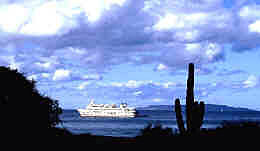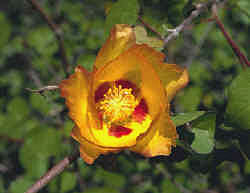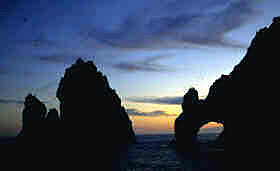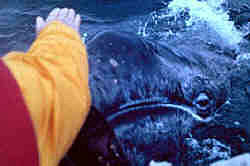Travel
Search
Surprising Baja |
|
Harlan Hague |
I swam with sea lions. That's how I answer anyone who asks about my Sea of Cortez cruise. I wonder whether the young sea lions told their buddies, I swam with humans. If so, they undoubtedly added: They're not very good swimmers.
I also petted whales, saw a green flash at sunrise, and marveled at magnificent sunsets and double rainbows. I walked through fields of wildflowers and up canyons that looked like gardens filled with blossoms and lush green foliage. This is Baja California?
Baja is best known for its awesome desert landscape and sport fishing. It has those qualities all right, but it can be much more. Abundant rains often turn the peninsula green. Seeds that lay dormant for seasons erupt in a shower of color.
I enjoyed these delights in February aboard a twelve-day cruise of
the M.V. Sea Bird. The composition of the staff
says much about the nature of the trip. In addition to the regular crew, the staff
included four naturalists, one of whom was titled Expedition Leader.
composition of the staff
says much about the nature of the trip. In addition to the regular crew, the staff
included four naturalists, one of whom was titled Expedition Leader.
Accommodating seventy-four passengers, the cabins on the one-class Sea Bird are all outside with individual climate control and large windows. Bow thrusters and an eight-foot draft permit the ship to navigate shallow waterways and anchorages. The ship carries a fleet of Zodiacs for shore excursions. Unlike most cruise ships, the Sea Bird and its sister ship, the Sea Lion, are registered in the United States and were built here in 1981 and 1982.
We boarded at Guaymas and the next morning headed westward across the gulf. We were hardly underway when a naturalist shouted over the PA system: "Dolphins coming in!" The sea suddenly boiled on all sides as bottlenose dolphins converged by the hundreds on the ship. A naturalist estimated a thousand. They cavorted around the ship and rode the bow wake for a minute, then they were gone. An auspicious beginning.
For the next few days, we visited islands and bays on Baja's east coast. At Isla San Pedro Martir, thousands of tropical birds, boobies, pelicans and other seabirds circled high above our Zodiacs and sat at their nests on the sheer cliffs. The island was mined for guano as late as the early twentieth century.
We went ashore at the islands of San Esteban, Isla Carmen, Isla Catalina, Isla Partida,
and Bahia San  Juanico on the Baja peninsula. Naturalists led walks,
commenting on plants and identifying birds. The serious birders in our group were thrilled
by our naturalist's prediction that we would see a hundred bird species during the
expedition (we did, exactly), including some that live only in Baja. A number of cacti and
other plants are also endemic to the peninsula or individual islands.
Juanico on the Baja peninsula. Naturalists led walks,
commenting on plants and identifying birds. The serious birders in our group were thrilled
by our naturalist's prediction that we would see a hundred bird species during the
expedition (we did, exactly), including some that live only in Baja. A number of cacti and
other plants are also endemic to the peninsula or individual islands.
I was excited, and a bit apprehensive, when we arrived at Los Islotes. These tiny volcanic islets are home to sea lions that were reputed to be both friendly and curious. If we are lucky, we were told, the young sea lions will swim with us.
The water was cold. We had been advised to bring at least a wet suit top, but my wife and I had not. Some passengers who had snorkeled at Isla Catalina--with wet suits-- confirmed that the water indeed was cold. Not to worry. We would snorkel here, even if we had to break ice.
The Zodiacs brought us to the little bay where the sea lions lay on rocky waterside ledges. The wet-suited swimmers went into the water first. One woman, wearing a full suit that would have kept her toasty in Glacier Bay, floated like a small Zodiac, then began to sink. She was pulled back into the boat.
It was my turn. I climbed down the ladder and yelled something like Ay caramba! as I entered the water and told myself that it wasn't bad at all. I adjusted my mask and immediately saw schools of brilliantly colored scissortail damselfish, yellowtail surgeonfish, largemouth blennie and silverstripe chromis. I swam to the other side of the Zodiac where the water was deeper and saw no fish at all. Suddenly a furry torpedo came straight at me. Two huge eyes looked directly into mine. At the last minute, the young sea lion veered off, missing me by a spare six inches.
I was still recovering when two sea lions streaked toward me, side by side. We had been told not to try to touch them, but I put my hand up anyway, not to touch them, but to try to avoid being bashed in the nose. I'll swear they smiled as they sheared off on each side of me. They stopped under me and drifted, watching me. I wondered what they were thinking. Then one swam idly over to the Zodiac anchor line, took it in its mouth and shook it. The other swam down to the anchor, then glided up the line, skimming it on its belly, all the way to the Zodiac.
The two youngsters swam by me, glancing at me as they passed, and joined another sea lion that was watching a wet-suited swimmer. The swimmer dived sharply, twisting and turning. The three animals joined in the play and frolicked around him.
When I surfaced, I saw that swimmers were boarding the Zodiac, and I followed. The boatswain counted. One missing. My wife. I looked toward the shore. There she was in the shallows, treading water and motioning to me.
Take my picture! she called. Over her head, I saw a huge bull sea lion on the rocky shore lumbering rapidly toward the water. Now we had been told that we could enjoy swimming with the young sea lions, but we should never, never swim when a bull was about. I yelled and motioned for her to swim to the boat.
Take my picture! The bull was at the water's edge. He was clearly signaling that the party was over, and the guests should go home now. I grabbed the nearest camera and snapped a picture. Carol swam to the boat, all smiles.
It could have been all downhill after swimming with sea lions, but we were just beginning. The next day, we boarded Zodiacs before dawn to visit a mangrove forest in a salt water estuary. The water was crystal clear and smooth as glass. As we left the estuary and entered the bay, we saw a strange craft approaching. It was a Zodiac fitted out with a linen-topped table, laden with urns containing coffee, tea and chocolate, and trays of muffins and croissants. We had left the ship before breakfast, having only snacks --fresh fruit, juices, coffee, tea, chocolate, banana bread, etc., etc.,--in the lounge, and the chief steward thought that we might need some fortification for the return trip. Ah, the rigors of adventure travel.
Underway again, we crowded the ship's bow to search for whales at the Gorda Banks, a shallow feeding grounds. They appeared first at a distance, then nearer the ship. Some tail-flopped--raising flukes above the water, waving, sometimes smacking the water hard, and there were some fantastic breaches. Two left the water almost simultaneously. Another breached near a small boat whose occupants must have been thrilled or frightened to distraction.
Our only port of call on Baja was Cabo San Lucas at the tip of the peninsula.
Passengers scattered, some to shop at the covered market, others to walk about the town,
some to Lover's Beach for  swimming and sunning. Carol and I spent our
day trying to find a sweatshirt our daughter had meant to buy when she and another
daughter visited Cabo a couple of weeks before. We also wanted to find the place where
they had hung out during their visit. We found the sweatshirt at the hangout: Squid Roe,
an aged funky eating and drinking place that must be great fun after sunset. We left Cabo
in late evening, the best time to see the famed rocks just outside the harbor. The sunset
was spectacular.
swimming and sunning. Carol and I spent our
day trying to find a sweatshirt our daughter had meant to buy when she and another
daughter visited Cabo a couple of weeks before. We also wanted to find the place where
they had hung out during their visit. We found the sweatshirt at the hangout: Squid Roe,
an aged funky eating and drinking place that must be great fun after sunset. We left Cabo
in late evening, the best time to see the famed rocks just outside the harbor. The sunset
was spectacular.
Our final destination was Bahia Magdalena where we expected to see gray whales close-up. But first we visited a large breeding colony of aptly-named magnificent frigatebirds in a mangrove forest. The nesting birds were quite undisturbed as our Zodiacs glided by their roosts. Hundreds of the birds, the males displaying inflated red throat sacs to attract females, soared above the colony. Afterwards, there was still time in the morning for a hike on Isla Margarita. Labeled desert on maps, rains had made our trail a garden.
In the afternoon, we set out in Zodiacs to look for gray whales at the southern entrance of Magdalena Bay. A rip tide over the shallow entrance generates swells of eight to ten feet, but whales favor the turbulence, so into it we charged. I fully expected the little boy of five years kneeling in the bow of our racing, pitching Zodiac to be thrown out. More than once, I started to reach for him. His mother, a few feet behind him, looked serenely at the waves. I made a mental note to ask her about her philosophy of child-rearing.
And we saw whales. First, footprints, a circular pattern of calm water on the ruffled surface, signaling that a whale had recently dived, then whales surfacing and blowing, often spy-hopping -- raising the head a few feet vertically from the water and looking about. The overcast sky threatened and the seas were rough, but the whale sightings made it worthwhile.
The next day, the ship cruised to the northern end of the bay, through the Hull Canal and anchored where the canal widens into a broad bay. The area is well known as a gray whale nursery. For some reason, orca whales, which will attack gray calves, do not come into this area, so the cows feel quite safe. We hoped to see some of these friendlies.
Our Zodiac had hardly pulled away from the ship when we sighted whales, singles and cows with calves. Contrary to a misconception, you do not chase whales; you put your boat in the vicinity of whales, and the whales initiate the contact. Swimming whales often stopped and spy-hopped to look at us. Some approached the Zodiac, a mother on one occasion even pushing her baby to the side of the boat where excited humans touched them. How often does one make friendly physical contact with a wild creature, at the initiation of that creature, in its own habitat?
A whale that we were watching swam slowly directly toward our Zodiac. About five feet
away, she surfaced, blew and looked me right in the eye, then
gently nudged the boat as she passed under the bow.
then
gently nudged the boat as she passed under the bow.
When I stroked her back, she paused a moment, and then was gone. Another whale that we had been slowly following stopped and let the boat drift over her. She gently raised the Zodiac, then let it down as gently.
The boatswain later told us about a woman on a previous trip who had gotten so excited while reaching to touch a whale that she fell from the Zodiac--right on top of the whale. She rolled off, submerged, and was pulled from the water, laughing aloud, by the boatswain.
Baja was a surprise. An expedition aboard a small, shallow-draft vessel, with a relaxed atmosphere and an ecologically aware program which combines the sea and the land, is the best way to see it. Sea Bird and Sea Lion are operated by Special Expeditions, whose motto is Dedicated to the Spirit of Discovery. Well said. This was eco-touring at its best.
For information and reservations, contact Special Expeditions, http://specialexpeditions.com/, explore@expeditions.com, 720 Fifth Avenue, New York, NY 10019, telephone 800-expedition. Write to the author with comments or questions.
|
Caveat and disclaimer: This is a freelance travel article that I published some time ago. Some data, especially prices, links and contact information, may not be current. |
|
|
|
|